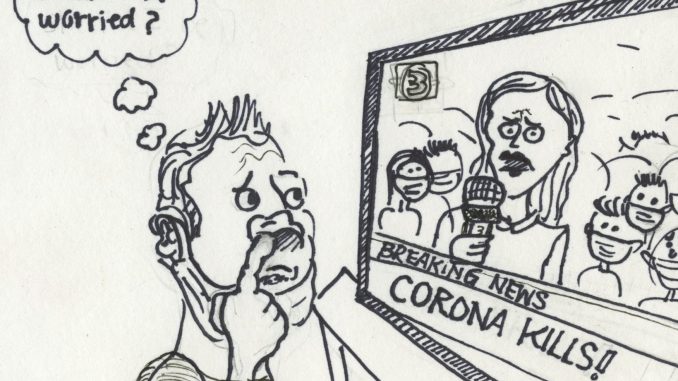
Over the weekend, the first case of Coronavirus in New York was confirmed. As the virus hits closer to home, Americans are entering crisis mode. Grocery stores are selling out of hand sanitizer, people are walking around wearing surgical masks and worst of all, no one really knows just how much of this is necessary.
Coronavirus, the name commonly associated with the particular virus that is quickly becoming a global epidemic, is actually an umbrella term for an entire family of viruses that includes a variety of illnesses, ranging from ordinary (common cold) to more extreme (severe acute respiratory syndrome). The name of the specific Coronavirus circulating at the moment is COVID-19.
COVID-19’s origins can be traced back to Wuhan, China, where the first case was reported in December of last year. Since then, the virus has spread rapidly, with over 95,000 confirmed cases and over 3,200 deaths across 83 territories, as of March 4. In the United States, the number of reported cases sits around 130, while the number of deaths is currently 11, as of March 4.
The uncertainty associated with the disease has caused mass confusion surrounding who is susceptible, and to what extent. Numerous experts have reported that those most at risk to the effects of the disease are the elderly, as well as those with compromised immune systems and those with “underlying chronic diseases,” such as chronic lung disease, chronic heart disease and diabetes, according to NPR. Though anyone can get Coronavirus, it is more likely to behave like the flu for those outside of these high-risk demographics. Symptoms include fever, cough and shortness of breath.
The magnitude of Coronavirus’ impact on the United States is hard to predict at this time, for a multitude of reasons — the main being that as of right now, medical professionals are severely lacking the testing materials required for the disease.
One Twitter user, @into_the_brush, detailed her experience attempting to obtain testing for the disease when she began exhibiting symptoms. She explains how after calling the Washington State Coronavirus hotline, she was placed on hold for 40 minutes before giving up. After reaching out to two primary care physicians, as directed to by the Center for Disease Control (CDC) website, she was told to call the hospital. Upon doing so, she was informed that testing was not available at the hospital, and was connected to the aforementioned hotline — once finally through, she was informed by an operator that only those who had been out of the country in the last 14 days or those who have been in contact with a confirmed carrier of the disease qualified for testing. If you weren’t a part of these two groups, she was told, you had to wait it out until your symptoms develop into pneumonia or bronchitis.
Unfortunately, this seems to be the case across the country. Though we have known the threat this virus would likely pose to our country since the end of last year, it seems that not much was done in preparation for its arrival. Of course, this shouldn’t come as too much of a shock under our current administration. Late last week, President Donald Trump confidently stated that the virus would “disappear… like a miracle.” This baffling statement comes after the President put Vice President Mike Pence — a man who frequently questions science — in charge of overseeing the containment and solutions to the virus. On Tuesday, Pence claimed that testing would become available to all Americans, regardless of their eligibility based on the CDC standards, but offered no insight into how and when these tests would become available.
The virus has also brought along with it rampant instances of racism, both intentional and ingrained. Since it originated in China, Asian people across the globe — and no, not just those of Chinese descent — are being subjected to racial profiling, acts of racism and social “othering.” According to CNN, Chinese-owned businesses are also suffering due to “Coronavirus anxiety.” The story, published on March 2, states that business experts are finding that “tourists and locals have been avoiding Chinese restaurants, shops and other businesses ever since news first broke about the Coronavirus outbreak in Wuhan, China.”
To think that local businesses are suffering due to fears relating to the disease when one would be putting themselves at just as high of a risk should they visit any public place is a shame. No cases of the virus have been reported in Chinatown, Manhattan, an area many tourists and locals alike are avoiding.
Another issue being exposed by the spread of the virus is the current United States healthcare system. In New York, Gov. Andrew Cuomo has ordered health insurance providers to waive any fees related to Coronavirus testing and treatment. Still, over one million individuals are without health insurance in New York alone — nationally, that number rises to 44 million.
The Trump Administration is currently looking into a “national disaster program to pay hospitals and doctors for their care of uninsured people with Coronavirus,” according to The Wall Street Journal. However, nothing has been confirmed regarding how uninsured Americans will receive treatment, or at a more basic level, access to testing.
To our readers, we offer a few pieces of advice in these alarming times: don’t panic, but stay smart — wash your hands, cover your cough, don’t touch your face, etc. Treat those around you with respect — a disease outbreak is not an excuse for racism. Finally, understand that this disease, though the effects of which are foreign to some, is harming people — remember to approach the topic with respect, and keep in mind those who are not fortunate enough to turn the epidemic into a meme.
